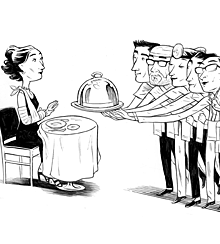Ordering up and financing health care in the U.S. looks like the proverbial Chinese food menu, picking and paying for “one from column A, and one from column C.” But that’s no way to operate a well-oiled machine for delivering quality health care, according to Healthcare Shifts from á la Carte to Prix Fixe from Strategy&, an analysis of the fragmented, high-cost and only fair quality American health system. One solution to this challenge is bundled payment.
“No one has an overarching view of the entire process,” the report opines, “with an eye toward improving customer service, quality, or costs.” Further exacerbating the sub-optimal patient outcomes is that people within the system are often passive players in their own care, without understanding the course or cost of treatment, and sometimes even what the treatment retail entails with respect to (1) process and (2) potential side-effects.
Bundled care is emerging at some pioneering organizations, coupling care with financing of “bundles” of procedures or services including all encounters, labor and products used for the entire course of the process. Think of this as the value-chain of care for a single price.
As such, the Strategy& team writes, bundles mean switching from an á la carte menu to a prix fixe menu.
The best cases for bundling in health care at this stage are standard processes like orthopedic or cardiac surgeries because they are fairly predictable (think: knees and heart by-pass procedures).
The challenges are many: willing consumers, but cautious employer-payors. and expanding bundles beyond hammer-and-nail procedures like bones and hearts.
Strategy&’s approach to bundling comes out of its HEALS program, which stands for healthy, acute and long-term solutions. See the link to this paper for a sidebar discussing HEALS.
Health Populi’s Hot Points: A key success factor in bundling isn’t so much the “bundling” itself, of getting the right services priced under one flat fee. Having studied bundles in health care for several years, the firm argues that the key success factor is getting the team right – it’s a multidisciplinary approach that makes the bundle work best. “The collaboration element among different roles is crucial, meaning that the method of delivering care will actually improve over time – akin to the continuous improvement concept in manufacturing.”
In reflecting the paradigm of menus, from á la carte to prix fixe, it’s further fodder making the case of health care in America moving toward the consumer retail mindset. In this case, the consumer is both the end-patient and the payor, namely the employer who foots the health insurance bill. Bundling is one strategy that can move payment from volume-to-value, to which employers are migrating. So we should think of consumers broadly when we say the word – payors are increasingly patients, and employers, consumers as well.





 I'm in amazing company here with other #digitalhealth innovators, thinkers and doers. Thank you to Cristian Cortez Fernandez and Zallud for this recognition; I'm grateful.
I'm in amazing company here with other #digitalhealth innovators, thinkers and doers. Thank you to Cristian Cortez Fernandez and Zallud for this recognition; I'm grateful. Jane was named as a member of the AHIP 2024 Advisory Board, joining some valued colleagues to prepare for the challenges and opportunities facing health plans, systems, and other industry stakeholders.
Jane was named as a member of the AHIP 2024 Advisory Board, joining some valued colleagues to prepare for the challenges and opportunities facing health plans, systems, and other industry stakeholders.  Join Jane at AHIP's annual meeting in Las Vegas: I'll be speaking, moderating a panel, and providing thought leadership on health consumers and bolstering equity, empowerment, and self-care.
Join Jane at AHIP's annual meeting in Las Vegas: I'll be speaking, moderating a panel, and providing thought leadership on health consumers and bolstering equity, empowerment, and self-care.